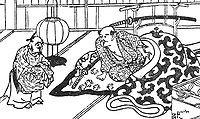Yōsei: Difference between revisions
Content deleted Content added
m Task 18 (cosmetic): eval 2 templates: hyphenate params (2×); |
No edit summary |
||
| Line 2: | Line 2: | ||
{{Redirect|Yousei|the 2013 visual novel|Yousei (video game)}} |
{{Redirect|Yousei|the 2013 visual novel|Yousei (video game)}} |
||
[[File:Akinari Zeni-no-sei.jpg|200px|right|thumb|The house spirits [[Zashiki warashi]], are described as being the size of a five or six-year-old child and prone to playing harmless pranks and occasionally causing mischief.]] |
[[File:Akinari Zeni-no-sei.jpg|200px|right|thumb|The house spirits [[Zashiki warashi]], are described as being the size of a five or six-year-old child and prone to playing harmless pranks and occasionally causing mischief.]] |
||
{{nihongo|'''Yōsei'''|妖精||lit. "bewitching spirit"|lead=yes}} is a [[Japanese language|Japanese]] word that is generally synonymous with the English term {{nihongo|''[[fairy]]''|フェアリー}}. Today, this word usually refers to spirits from [[Western world|Western]] legends, but occasionally it may also denote a creature from native Japanese [[folklore]]. For example, according to an old folk belief from [[Iwate Prefecture]], it was once feared that the ''yōsei'' could |
{{nihongo|'''Yōsei'''|妖精||lit. "bewitching spirit"|lead=yes}} is a [[Japanese language|Japanese]] word that is generally synonymous with the English term {{nihongo|''[[fairy]]''|フェアリー}}. Today, this word usually refers to spirits from [[Western world|Western]] legends, but occasionally it may also denote a creature from native Japanese [[folklore]]. For example, according to an old folk belief from [[Iwate Prefecture]], it was once feared that the ''yōsei'' could [resurrect]] the dead. It is also mentioned that the people of [[Mount Penglai|Mt. Hōrai]] are small fairies that have no knowledge of great evil and so their hearts never grow old. The [[Ainu people|Ainu]] also tell of a race of small people known as the [[Koro-pok-guru]] in their folklore. Another fairy-like being from Japan is the [[Kijimuna]], tree sprites told in the [[Ryukyuan religion]] of [[Okinawa]]. |
||
==See also== |
==See also== |
||
Revision as of 19:24, 8 October 2021
This article includes a list of references, related reading, or external links, but its sources remain unclear because it lacks inline citations. (September 2018) |

Yōsei (Japanese: 妖精, lit. "bewitching spirit") is a Japanese word that is generally synonymous with the English term fairy (フェアリー). Today, this word usually refers to spirits from Western legends, but occasionally it may also denote a creature from native Japanese folklore. For example, according to an old folk belief from Iwate Prefecture, it was once feared that the yōsei could [resurrect]] the dead. It is also mentioned that the people of Mt. Hōrai are small fairies that have no knowledge of great evil and so their hearts never grow old. The Ainu also tell of a race of small people known as the Koro-pok-guru in their folklore. Another fairy-like being from Japan is the Kijimuna, tree sprites told in the Ryukyuan religion of Okinawa.
See also
References
- "Definition: Yōsei". Daijirin Dictionary. Retrieved 2007-07-20.
- "Yōsei". Kaii-Yōkai Denshō Database. Retrieved 2007-07-20.
